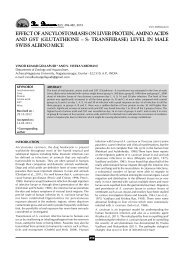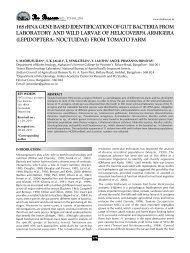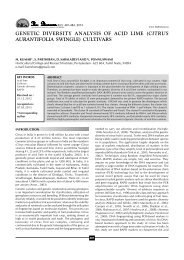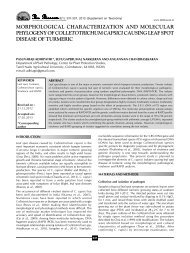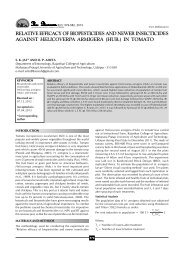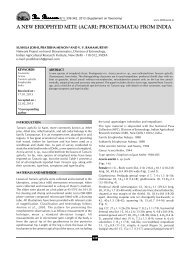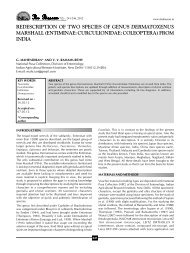fullpaper - THE BIOSCAN
fullpaper - THE BIOSCAN
fullpaper - THE BIOSCAN
Create successful ePaper yourself
Turn your PDF publications into a flip-book with our unique Google optimized e-Paper software.
PRODUCTION OF ENTOMPATHOGENIC FUNGI<br />
it also supported satisfactory growth and sporulation of<br />
B.bassiana in our experiments also. In the case of Verticillium<br />
lecanii, sorghum was found to be the ideal cereal for mass<br />
production, which is in confirmation with the findings of<br />
Lakshmi et al. (2001). The ability of an entomopathogenic<br />
fungus to grow on different pests depends on the nutrients<br />
present on the insect body which is directly based on the<br />
plant they feed (Ambethagar et al., 1998). The present study<br />
also supported this fact in which among several naturally<br />
available substrates tested for mass multiplication of B.<br />
bassiana SDB and Pea seeds are most suitable for its growth<br />
and development. Moreover, B.bassiana has wide host range<br />
and it was isolated from pests of banana (Kaaya et al., 1991),<br />
rice (Puzari et al., 1997), cashew (Ambethagar, 1991, 1996,<br />
and 1997), beans (Landa, 1984), crucifers (Butt et al., 1994),<br />
chickpea and pigeonpea (Gopalkrishnan and Narayanan,<br />
1988) around the world. Previous workers have also<br />
successfully used agro-wastes such as crushed maize cobs,<br />
wheat bran, rice bran, bagasse and press mud singly and<br />
along with supplementation for mass multiplication of<br />
Metarhizium and Verticillium (Vimaladevi and Prasad, 1996).<br />
The use of different agricultural wastes is economical and<br />
also helps in their efficient utilization. For a successful<br />
integrated pest management programme, the agents like the<br />
entomopathogenic fungi should be amenable to easy and<br />
cheap mass multiplication. From this study it was clear that<br />
the test fungus is able to grow on a variety of cheap and easily<br />
available grains. These grains can be used for the mass<br />
multiplication of the fungus and it may increase its efficiency<br />
as a biocontrol agent which is also economic and easily<br />
available. Refined experiments using other easily available<br />
nutrient sources like corn steep liquor, rice and wheat straw,<br />
corn stalks and other agricultural wastes will probably provide<br />
more information on the utility of different agro wastes for<br />
production of entomopathogenic fungi.<br />
REFERENCES<br />
Alter, J. A. and Vandenberg, J. J. D. 2000. Factors that Influencing<br />
the Infectivity of Isolates of Paecilomyces fumosoroseus Agains<br />
Diamond Back Moth. J. Invertebr Pathol. 78: 31-36.<br />
Alves, S. B. and Pereira, R. M. 1989. Production of Metarhizium<br />
anisopliae and Beauveria bassiana. Ecosustania. 14: 188-192.<br />
Ambethgar, V. 1991. Biochemistry of epizootics of the fly fungus,<br />
Pandora delphacis (hort.) Humber in the rice brown plant hopper,<br />
Nilaparvata lugens (Stal), M.Sc.(Agri.) Thesis, Annamalai University,<br />
Tamil Nadu, India.<br />
Ambethgar, V. 1996. Biological control of brown plant hopper<br />
Nilaparvata lugens with entomogenous fungi. Madras Agri. J. 8: 203-<br />
204.<br />
Ambethgar, V. 1997. Record of white muscardius fungus, Beauveria<br />
bassiana (Bals.) Vuill. On rice leaf folder complex from Karaikol.<br />
Pondicherry Union Territory (India). J. Ento. Res. 21: 197-199.<br />
Ambethgar, V., Lakshmanam, V. and Dinakaran, D. 1998. Bio control<br />
agent for cashew borers. The Hindu, May 28, p.24.<br />
Avery, P. B., Faulla, J. and Simmands, M. S. J. 2004. Effect of Different<br />
Photoperiods on the Infectivity and Colonization of Paecilomyces<br />
fumosoroseus. J. Insect Sci. 4: 38.<br />
Babu, V., Murugan, S. and Thangaraja, P. 2001. Laboratory Studies<br />
on the Efficacy of Neem and the Entomopathogenic Fungus Beauveria<br />
bassiana on Spodoptera litura”. Entomology. 56: 56-63.<br />
Burges, A. D. and Hussey, N. W. 1981. Microbial Control of Insect<br />
Pests and Mite, Academic Press, London, pp. 161-167.<br />
Butt, T. M., Ibrahim, L., Ball, B. V. and Clark, S. J. 1994. Pathogenicity<br />
of the entomogenous fungi Metarhizium anisopliae and Beauveria<br />
bassiana against crucifer pests and the honeybee. Bio. Ser. Tech. 4:<br />
207-217.<br />
Butt, T. M., Jackson, C. W. and Murugan, W. 2001. Fungi as Biocontrol<br />
Agents,Progress,Problems and Potentials. CBBS Publshing Co, UK,<br />
pp. 240-242.<br />
Dangar, T. K., Geetha, L., Jayapal, S. D. and Pillai, G. B. 1999. Mass<br />
Production of the Entomopathogens Metarhizium anisopliae in<br />
Coconut Water. J. Plant. Crop. 19: 54-59.<br />
Feng, M. G., Paponsk, T. J. and Kbachachiurians, G. G. 1994.<br />
Production, Formulation and Application of the Entomopathogenic<br />
Fungus Beauveria bsssiana For Insect Control. Biocontrol Sci. Technol.<br />
4: 531-544.<br />
Gopalakrishnan, C., Anusuya, D. and Narayanan, K. 1999. In vitro<br />
Production of Conidia of Entomopathogenic Fungus Parcilomyces<br />
farinosus. Entomology. 24: 389-392.<br />
Gopalkrishnan, C. and Narayanan, K. 1988. Occurrence of two<br />
entomofungal pathogens, Metarhizium anisopliae(Metschinkoff)<br />
Sorokin var. minor Tulloch and Nomuraea rileyi on Heliothis armigera.<br />
Curr. Sci. 57: 867-868.<br />
Humber, R. A. 1997. Manual OJ Techniques in Insect Pathology<br />
Academic Pree, London pp. 153-155.<br />
Ibrahim, Y. B. and Low, W. 1993. Potential of Mass Production and<br />
Field Efficacy of Isolates of the Entomopathoghenic Fungi Beauveria<br />
bassiana and Paecilomyces fumosoroseus on Plutella xylostella. J.<br />
Invertebr. Pathol. 39: 222-232.<br />
Im, D. J., Lee, M. H., Aguda, R. M. and Rombach, M. C. 1988. Effect<br />
of nutrients on pH on the growth and sporulation of four<br />
entomogenous hypomycetes fungi (Deuteromycotina). Korean J.<br />
Appl.Ento. 27: 41-46.<br />
Kaaya, G. P., Kokwaro, E. D. and Murithi, J. 1991. Mortalities in<br />
adult Glossina morsitans experimentally infected with the<br />
entomogenous fungi, Beauveria bassiana and Metarhizium anisopliae.<br />
Dis. Inno. 3: 55-60.<br />
Lakshmi, S. M., Alagammai, P. L. and Jayaraj, K. 2001. Studies on<br />
Mass Culturing of the Entomopathogen Whitehalo Fungus Verticillium<br />
lecanii on Three Grain Media and Its Inefficacy on Helicoverpa<br />
armigera, In Igbachimuthu S, Sen S (Eds.) Microbials In Insect Pest<br />
Management, Oxford and IBH publishing Pvt Ltd, New Delhi, pp.<br />
23- 27.<br />
Landa, Z. 1984. Protection against glasshouse whitefly, Trialeurodicus<br />
vaporariorum in integrated protection programmes for glasshouse<br />
chambers. Sbor. Ur. Zahor. 11: 215-218.<br />
Noris, R. F., Chen, E. P. S. and Kogn, M. 2002. Concepts in integrated<br />
Pest Management. Premise Hall of India Private Limited, New Delhi.<br />
Patel, K. C., Yadaw, D. V., Dube, H. C. and Patel, R. J. 1990.<br />
Laboratory and Mass Production Studies With Metarhizium anisopliae.<br />
Annu. Biol. 6: 135-138.<br />
Puzari, K. C., Sharma, D. K. and Saranka, L. K. 1997. Media for Mass<br />
Production of Beauveria bassiana. J. Biol. Contr. 11: 96-100.<br />
Riba, G. and Glande, A. 1980. Development of a nutritive medium<br />
for deep culture of the entomopathogenic fungus, Nomuraea rileyi.<br />
Entomophaga. 25: 317-322.<br />
Romback, M.C. 1989. Production of Beauveria bassinaa Conidia in<br />
Submerged Culture. Entomophaga. 5: 45-52.<br />
Rousson, S., Rainbautt, M. and Lonsane, B. K. 1983. Zymotics a<br />
Large Scale Fermenter Design and Evaluation, Appl. Biochem.<br />
Biotechnol. 42: 161-167.<br />
231



